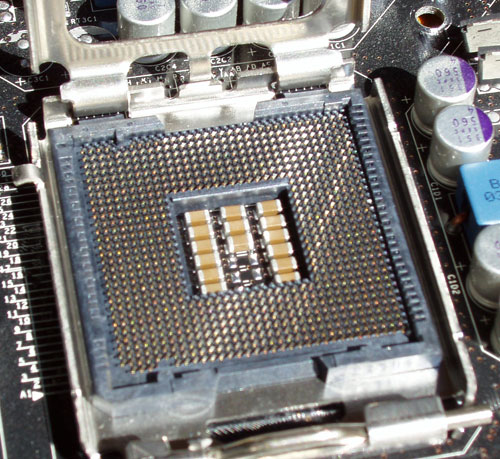
Original Link: https://www.anandtech.com/show/1543
Intel's Pentium 4 570J - Will 3.8GHz do the trick?
by Anand Lal Shimpi on November 14, 2004 10:56 AM EST- Posted in
- CPUs
March of 2000 marked a very interesting time for AMD and Intel; just two days apart, each company broke the 1GHz barrier with an extremely high priced, low yield, barely available CPU – and users stood in awe. Today, Intel quietly introduces a Pentium 4 running at 3.8GHz, and the excitement is nowhere to be found.
Maybe it’s that the 3.8GHz clock speed is hidden behind the 570J model number. Maybe it’s that our latest benchmarks have shown that it’d take much more than 3.8GHz for Intel to truly regain the performance crown. Or maybe it’s the cancellation of the 4GHz Pentium 4 that has robbed the 3.8GHz model’s 15 minutes of fame. Then again, this isn’t the first time we’ve reviewed a speed-bump without getting too excited, so maybe business is just as usual.
The Intel Pentium 4 570J is the topic of discussion today; the 570 represents a Prescott core clocked at 3.8GHz, an increase of 200MHz over the Pentium 4 560. The Pentium 4 570J will fit in at the $637 price point (in 1K unit quantities), and will be faced with limited initial availability.
Since the CPU is labeled using Intel’s model numbering system it is meant for LGA-775 platforms only, which is in line with Intel’s plan to bring the Socket-478 platform to an end very soon. The J-suffix simply indicates support for Intel’s Execute Disable Bit (EDB), identical to AMD’s NX bit.
Enabled (on Windows) through Service Pack 2, EDB and NX prevent programs from executing malicious code contained within various parts of memory. We’ve talked briefly about EDB/NX here on AnandTech, and Microsoft also has an informative page on the specifics of Service Pack 2’s support for the technologies.
Architecturally, other than the inclusion of EDB support, the Pentium 4 570J remains unchanged from all previous Prescott based CPUs. If you want to understand a bit more about Prescott’s architecture be sure to read our extensive coverage of the technology and improvements/shortcomings of Intel’s flagship core. But if you’re already up to speed, let’s get right to it.
Testing EDB Functionality
As we just mentioned, Intel’s Execute Disable Bit is enabled through Windows XP Service Pack 2, but being proponents of testing as many supported features as possible we turned to Robert Schlabbach’s Data Execution Prevention Test (aka NXTEST) to test Intel’s EDB.
CPUs that support Data Execution Prevention (DEP) will have to run in Physical Address Extension mode in order to enable DEP support. You can confirm the operating status by looking at the System Properties control panel:
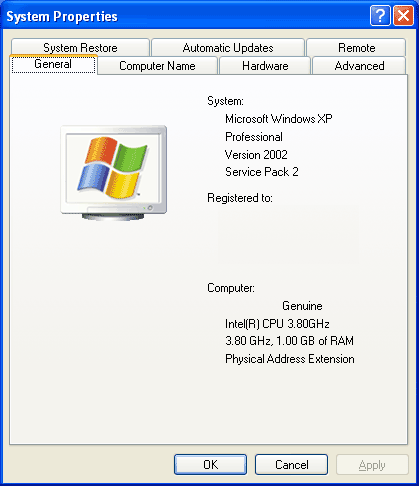
Physical Address Extension should be listed here.
Before setting up NXTEST you have to enable full Data Execution Prevention under SP2. By default DEP is only enabled for certain Windows programs and services, given that NXTEST is not one off those Windows programs and services we had to manually enable DEP for all programs.
Microsoft buries the DEP controls under the Performance Options control panel, to get there you must first visit the System Properties control panel:

Then click on the advanced tab and select the Performance Settings option.
The third tab in the Performance Options control panel is the Data Execution Prevention tab, which is where you can enable/disable system-wide DEP:

A reboot later we were ready to run NXTEST:

As expected, running the test confirmed that Intel’s EDB was working properly:

Intel didn’t make a huge deal out of EDB support for two likely reasons: 1) AMD beat them to the punch with their NX bit support, and 2) the benefits are not as tangible to end users since EDB doesn’t prevent all types of malicious code from wreaking havoc on your system, neither Intel nor AMD wish to inspire false confidence in their processors’ abilities to provide greater security.
An update on LGA-775
When Intel first launched the LGA-775 socket we were skeptical; reports of extremely high failure rates of initial sockets were pouring out of Taiwan and we had feared the worst: had Intel finally broken all ties with the enthusiast community by implementing a socket that would fail after a couple of insertions?
Now, 5 months after the public introduction of LGA-775, we can say that our deepest fears didn’t end up materializing. We’ve done a tremendous number of LGA-775 CPU installations over the past several months across various motherboards and have yet to encounter a system that will no longer POST or even a single bent pin on the motherboard.
We do have complaints about Intel’s retail heatsink/fan and its mounting mechanism. While we were originally quite impressed with how much easier the LGA-775 HSF mounted than the older Socket-478 units, the more we used them, the more we began to despise them just as much as we did the previous model.
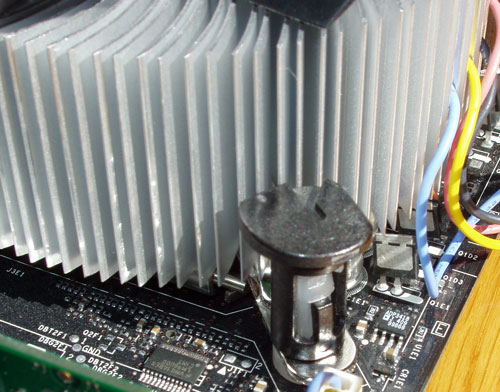
The problem with the new heatsink is that it is very easy to not get all of the four pegs to lock into place properly, which usually results in a clock throttling CPU that’s difficult to detect. The issue seems to be much more common on the higher speed Prescotts (3.6GHz and 3.8GHz); the first time you mount the heatsink it’s usually not a problem, but remove it and reinstall it a few times and now things aren’t quite as perfect. The pegs don’t always lock into place securely and we’ve had cases where one of the pegs will pop out of place. Usually if you spend more time with it and apply a good amount of pressure to the culprit pegs you’ll avoid any issues. It’s not an unsurmountable problem but it’s definitely an annoyance we’ve had since the launch of the LGA-775 socket.
We much prefer AMD’s simple, single lever approach to heatsink installation as it is effortless and we’ve never had an issue with an improperly cooled CPU. To Intel’s credit, the Pentium 4 does produce significantly more heat than the Athlon 64 so maintaining better contact between the heatsink and the CPU is much more important to Intel than AMD, but that doesn’t change the fact that Intel’s heatsink can be a pain to install and reinstall.
The worries of users bending pins in the socket and returning their motherboards also doesn’t seem to be a real issue as we haven’t heard any complaints from the Taiwanese motherboard manufacturers.
AMD Athlon 64 4000+ and Intel Pentium 4 570J: Head to Head
We've got our entire suite of benchmarks with all of the various processor speeds in the coming pages, but we thought we'd start this review out with the comparison that made the most sense: the Pentium 4 570J vs. the AMD Athlon 64 4000+. Both chips are at virtually identical price points (the 4000+ sells for around $680, which is where we expect the 570J to be) and are the flagship desktop CPUs from both companies (not including the Extreme Edition and FX series).
The comparison uses all of our normal tests, but simply singles out these two processors as the only contenders. If you are interested in seeing a broad picture of AMD vs. Intel, the forthcoming pages will be able to give you just that. This page is mostly for those readers who have kept up with the recent CPU reviews at AnandTech and just want an update on how the 570J changes things, so here we go:
Intel is unusually competitive in the Business/General Usage tests which is absolutely not the norm. Despite Intel's strengths, a couple of the tests greatly favored AMD (Mozilla and WinRAR), giving AMD the advantage here.
| Business/General Use | |||
AMD Athlon 64 4000+ |
Intel Pentium 4 570J |
Performance Advantage |
|
| Business Winstone 2004 | 23.6 |
22.2 |
6.31% |
| SYSMark 2004 - Communication | 150 |
144 |
4.17% |
| SYSMark 2004 - Document Creation | 195 |
207 |
5.80% |
| SYSMark 2004 - Data Analysis | 146 |
195 |
25.13% |
| Microsoft Office XP with SP-2 | 521 |
509 |
2.36% |
| Mozilla 1.4 | 279 |
478 |
41.63% |
| ACD Systems ACDSee PowerPack 5.0 | 485 |
482 |
0.62% |
| Ahead Software Nero Express 6.0.0.3 | 492 |
514 |
4.28% |
| WinZip Computing WinZip 8.1 | 398 |
394 |
1.02% |
| WinRAR | 632 |
485 |
30.31% |
| Winner | - |
- |
AMD |
The performance breakdown is somewhat close under the Multitasking Content Creation tests, with AMD even walking away with a win in the mutltiasking encoder test, but AMD's advantages of victory are not as frequent nor as large as Intel's.
| Multitasking Content Creation | |||
AMD Athlon 64 4000+ |
Intel Pentium 4 570J |
Performance Advantage |
|
| Content Creation Winstone 2004 | 36.1 |
33.8 |
6.80% |
| SYSMark 2004 - 3D Creation | 205 |
241 |
14.94% |
| SYSMark 2004 - 2D Creation | 260 |
298 |
12.75% |
| SYSMark 2004 - Web Publication | 187 |
218 |
14.22% |
| Mozilla and Windows Media Encoder | 550 |
583 |
5.66% |
| Winner | - |
- |
Intel |
We've been impressed at how close things have been thus far and our Video Creation/Photo Editing tests make things even closer, with both camps trading wins resulting in a virtual tie. It looks like Photoshop performance is identical between the two chips and while AMD is faster under Premier, Intel is faster under Movie Creator by about the same percentage.
| Video Creation/Editing | |||
AMD Athlon 64 4000+ |
Intel Pentium 4 570J |
Performance Advantage |
|
| Adobe Photoshop 7.0.1 | 314 |
320 |
1.88% |
| Adobe Premiere 6.5 | 368 |
429 |
14.22% |
| Roxio VideoWave Movie Creator 1.5 | 306 |
265 |
15.47% |
| Winner | - |
- |
Tie |
The encoding tests clearly go to Intel, AMD isn't able to muster up a single win here although they are close with the audio encoding Jukebox test. The performance advantages held by Intel are very strong in the DivX, XviD and WME9 tests.
| Audio/Video Encoding | |||
AMD Athlon 64 4000+ |
Intel Pentium 4 570J |
Performance Advantage |
|
| MusicMatch Jukebox 7.10 | 458 |
437 |
4.81% |
| DivX Encoding | 48.7 |
58.1 |
16.18% |
| XViD Encoding | 32.8 |
35.3 |
7.08% |
| Microsoft Windows Media Encoder 9.0 | 2.23 |
2.73 |
18.32% |
| Winner | - |
- |
Intel |
While Intel took all of the encoding tests, AMD still can't be beat when it comes to gaming performance. It is going to take a lot more than 3.8GHz to tilt the balance in Intel's favor here. Given what we've seen with the performance of the Extreme Edition chips under our gaming tests, we'd hypothesize that even Intel's 600 series of Pentium 4s won't be able to dethrone AMD as the gaming performance leader.
| Gaming | |||
AMD Athlon 64 4000+ |
Intel Pentium 4 570J |
Performance Advantage |
|
| Doom 3 | 100.7 |
87.1 |
15.61% |
| Sims 2 | 56.5 |
49.7 |
13.68% |
| CS: Source | 185.6 |
148 |
25.41% |
| Halo | 96.7 |
88.9 |
8.77% |
| Far Cry | 154.9 |
135.1 |
14.66% |
| Star Wars Battlefront | 145 |
141 |
2.84% |
| Battlefield Vietnam | 240 |
240 |
0.00% |
| UT2004 | 70.9 |
61.1 |
16.04% |
| Wolf: ET | 108.9 |
101.2 |
7.61% |
| Warcraft III | 62 |
61 |
1.64% |
| Winner | - |
- |
AMD |
Both AMD and Intel trade wins in the 3D rendering tests, however AMD's two wins are in the same test (just different APIs) and the margin of victory is much lower than Intel's victory in the SPECapc 3dsmax 6 test, so when it comes to 3dsmax rendering performance the nod goes to the 570J.
| 3D Rendering | |||
AMD Athlon 64 4000+ |
Intel Pentium 4 570J |
Performance Advantage |
|
| Discreet 3ds max 5.1 (DirectX) | 244 |
252 |
3.17% |
| Discreet 3ds max 5.1 (OpenGL) | 300 |
314 |
4.46% |
| SPECapc 3dsmax 6 | 1.53 |
1.75 |
12.57% |
| Winner | - |
- |
Intel |
Unusually close, our SPECviewperf tests show a very heated battle between the two chips, but AMD manages to secure two major victories that give them the performance crown here. AMD's performance under our Visual Studio 6 compile test makes it clear that developers working on large projects need to be using the Athlon 64 to keep compile times as low as possible; with almost a 20% performance advantage in compile time, the Athlon 64 will make a huge difference in how long it takes to compile large projects.
| Professional Apps | |||
AMD Athlon 64 4000+ |
Intel Pentium 4 570J |
Performance Advantage |
|
| SPECviewperf 8 - 3dsmax-03 | 16.78 |
17.45 |
3.84% |
| SPECviewperf 8 - catia-01 | 14.04 |
14.43 |
2.70% |
| SPECviewperf 8 - light-07 | 14.32 |
14.78 |
3.11% |
| SPECviewperf 8 - maya-01 | 18.61 |
13.79 |
34.95% |
| SPECviewperf 8 - proe-03 | 17.31 |
17.16 |
0.87% |
| SPECviewperf 8 - sw-01 | 13.8 |
13.45 |
2.60% |
| SPECviewperf 8 - ugs-04 | 16.05 |
15.85 |
1.26% |
| Visual Studio 6 | 12.8 |
15.7 |
18.47% |
| Winner | - |
- |
AMD |
While we expected this review to be more of the usual, we were pleasantly surprised to see that the Pentium 4 570J is actually a fairly strong competitor to AMD's Athlon 64 4000+. Part of the reason behind this is because AMD didn't actually increase the clock speed of the 4000+, it still runs at the same 2.4GHz as the 3800+, albeit with a larger L2 cache. Had AMD released a 2.6GHz Athlon 64 4000+ Intel would have had a more difficult time with the 570J, but given that things are the way they are our CPU recommendation is split between the two.
Gamers, business users, developers and the general public will find that the Athlon 64 4000+ is faster in the types of applications they run. However content producers or anyone that does a good deal of video encoding or 3D rendering will find that the Pentium 4 570J will offer better performance for their applications. AMD still does better overall, but Intel does a very good job of hanging onto the performance crown in a handful of specific areas.
Remember that the recommendations change as soon as you start looking at lower price points, but at this $600 - $700 the recommendations above are quite valid.
For those of you looking for comparisons at the $200 and $500 price points we've already done these investigations in previous articles so be sure to check them out as well. For those of you who haven't been following our CPU coverage lately we've included our normal performance graphs comparing the Pentium 4 570J to the rest of the current CPU market over the coming pages.
The Test
In addition to our usual tests we've included PC World's WorldBench 5, an application based test suite much like Winstone and SYSMark that incorporates many popular applications. Unlike the aforementioned benchmarks, WorldBench does not test multitasking power, rather focusing on single application performance, making it very complementary to our existing benchmarks. The one thing to keep in mind about the WorldBench results is that the variation between test runs can be pretty significant; we do everything to make sure that the results are as consistent as possible (multiple runs, throwing out outliers, etc...) but the variation between runs in these tests can be as high as 6% - thus we would suggest looking at performance differences only greater than 10% in these tests for any sort of significance. The rest of the tests have variations between runs of 1 - 3%.
Our hardware configurations are similar what we've used in previous comparisons, with one addition - our Athlon 64 testbed now uses the recently released nForce4 chipset. For a review of that chipset read our own Wesley Fink's review of NVIDIA's latest chipset with SLI support.
AMD Athlon 64 Configuration
Socket-939 Athlon 64 CPUs
2 x 512MB OCZ PC3200 EL Dual Channel DIMMs 2-2-2-10
NVIDIA nForce4 Reference Motherboard
ATI Radeon X800 XT PCI Express
AMD Athlon XP Configuration
Athlon XP 3200+
2 x 512MB OCZ PC3200 EL Dual Channel DIMMs 2-2-2-10
ASUS A7N8X Deluxe nForce2 400 Motherboard
ATI Radeon X800 XT AGP
Intel Pentium 4 Configuration
LGA-775 Intel Pentium 4 and Extreme Edition CPUs
2 x 512MB Crucial DDR-II 533 Dual Channel DIMMs 3-3-3-12
Intel 925XE Motherboard
ATI Radeon X800 XT PCI Express
Business/General Use Performance
Business Winstone 2004
Business Winstone 2004 tests the following applications in various usage scenarios:
. Microsoft Access 2002
. Microsoft Excel 2002
. Microsoft FrontPage 2002
. Microsoft Outlook 2002
. Microsoft PowerPoint 2002
. Microsoft Project 2002
. Microsoft Word 2002
. Norton AntiVirus Professional Edition 2003
. WinZip 8.1

Office Productivity SYSMark 2004
SYSMark's Office Productivity suite consists of three tests, the first of which is the Communication test. The Communication test consists of the following:
"The user receives an email in Outlook 2002 that contains a collection of documents in a zip file. The user reviews his email and updates his calendar while VirusScan 7.0 scans the system. The corporate web site is viewed in Internet Explorer 6.0. Finally, Internet Explorer is used to look at samples of the web pages and documents created during the scenario."

The next test is Document Creation performance, which shows very little difference in drive performance between the contenders:
"The user edits the document using Word 2002. He transcribes an audio file into a document using Dragon NaturallySpeaking 6. Once the document has all the necessary pieces in place, the user changes it into a portable format for easy and secure distribution using Acrobat 5.0.5. The user creates a marketing presentation in PowerPoint 2002 and adds elements to a slide show template."
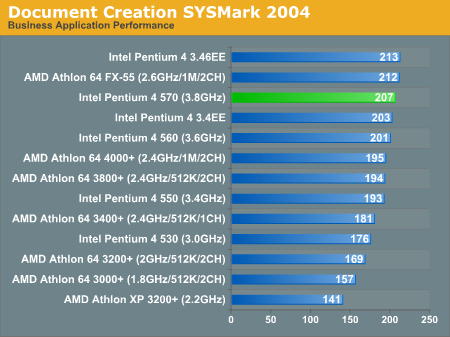
The final test in our Office Productivity suite is Data Analysis, which BAPCo describes as:
"The user opens a database using Access 2002 and runs some queries. A collection of documents are archived using WinZip 8.1. The queries' results are imported into a spreadsheet using Excel 2002 and are used to generate graphical charts.
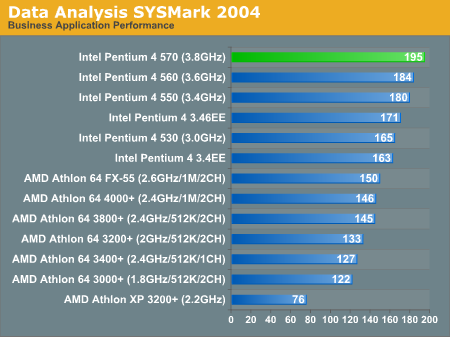
Microsoft Office XP SP-2
Here we see in that the purest of office application tests, performance doesn't vary all too much.
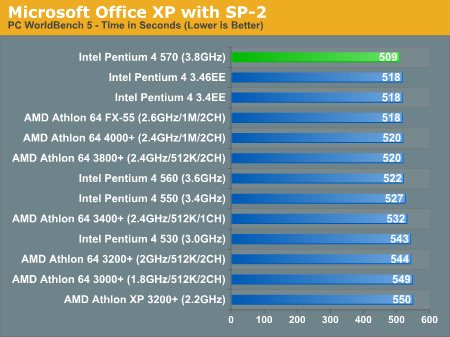
Mozilla 1.4
Quite possibly the most frequently used application on any desktop is the one we pay the least amount of attention to when it comes to performance. While a bit older than the core that is now used in Firefox, performance in Mozilla is worth looking at as many users are switching from IE to a much more capable browser on the PC - Firefox.
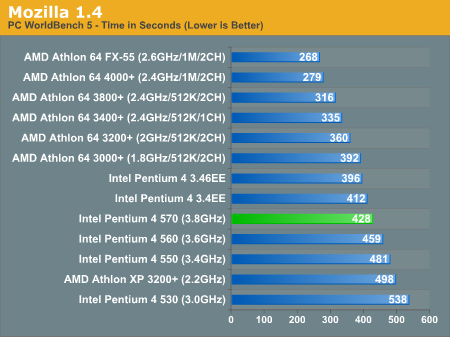
ACD Systems ACDSee PowerPack 5.0
ACDSee is a popular image editing tool that is great for basic image editing options such as batch resizing, rotating, cropping and other such features that are too elementary to justify purchasing something as powerful as Photoshop for. There are no extremely complex filters here, just pure batch image processing.
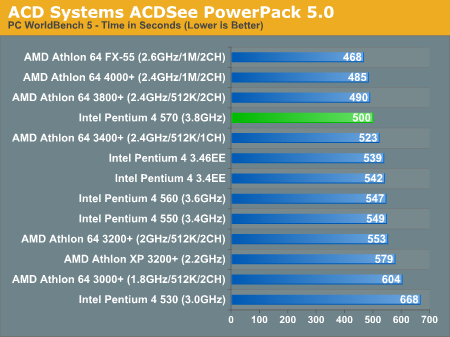
Ahead Software Nero Express 6.0.0.3
While it was a major issue in the past, these days buffer underrun errors while burning a CD or DVD are few and far between thanks to high performance CPUs as well as vastly improved optical drives. When you take the optical drive out of the equation, how do these CPU's stack up with burning performance?
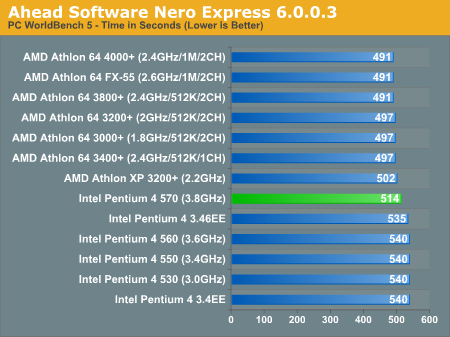
Winzip
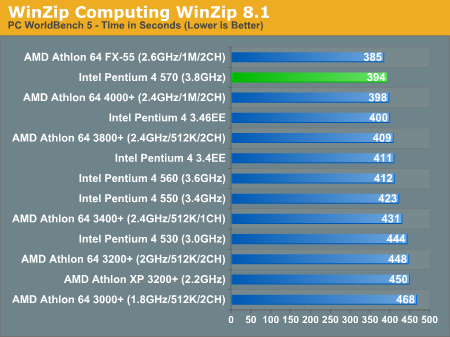
WinRAR 3.40
Pulling the hard disk out of the equation we can get a much better idea of which processors are truly best suited for file compression. While the hard drive hid a lot of the shortcomings of the Athlon XP in WorldBench's WinZip test, they are all revealed in WinRAR's built in benchmark that is largely disk I/O independent.
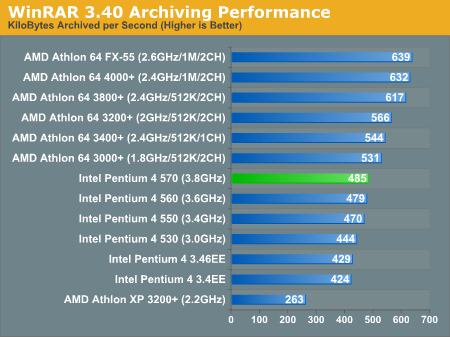
Multitasking Content Creation
MCC Winstone 2004
Multimedia Content Creation Winstone 2004 tests the following applications in various usage scenarios:
. Adobe® Photoshop® 7.0.1
. Adobe® Premiere® 6.50
. Macromedia® Director MX 9.0
. Macromedia® Dreamweaver MX 6.1
. Microsoft® Windows MediaTM Encoder 9 Version 9.00.00.2980
. NewTek's LightWave® 3D 7.5b
. SteinbergTM WaveLabTM 4.0f
As you can see above, Lightwave is part of the MCC Winstone 2004 benchmark suite. As an individual application, Lightwave does manage to get a healthy performance benefit with multithreaded rendering enabled, especially when paired with Hyperthreading enabled CPUs like the Pentium 4s here today. All chips were tested with Lightwave set to spawn 4 threads.
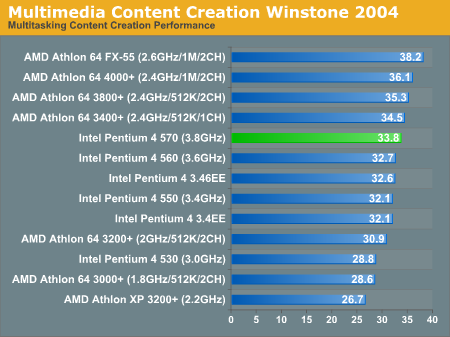
ICC SYSMark 2004
The first category that we will deal with is 3D Content Creation. The tests that make up this benchmark are described below:
"The user renders a 3D model to a bitmap using 3ds max 5.1, while preparing web pages in Dreamweaver MX. Then the user renders a 3D animation in a vector graphics format."

Next, we have 2D Content Creation performance:
"The user uses Premiere 6.5 to create a movie from several raw input movie cuts and sound cuts and starts exporting it. While waiting on this operation, the user imports the rendered image into Photoshop 7.01, modifies it and saves the results. Once the movie is assembled, the user edits it and creates special effects using After Effects 5.5."
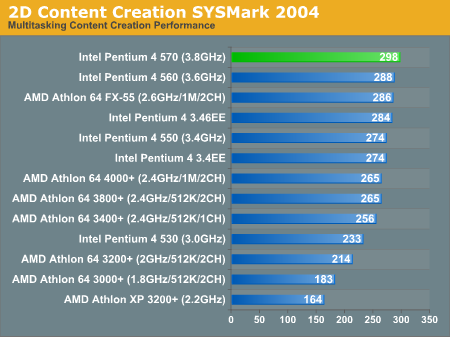
The Internet Content Creation suite is rounded up with a Web Publishing performance test:
"The user extracts content from an archive using WinZip 8.1. Meanwhile, he uses Flash MX to open the exported 3D vector graphics file. He modifies it by including other pictures and optimizes it for faster animation. The final movie with the special effects is then compressed using Windows Media Encoder 9 series in a format that can be broadcast over broadband Internet. The web site is given the final touches in Dreamweaver MX and the system is scanned by VirusScan 7.0."
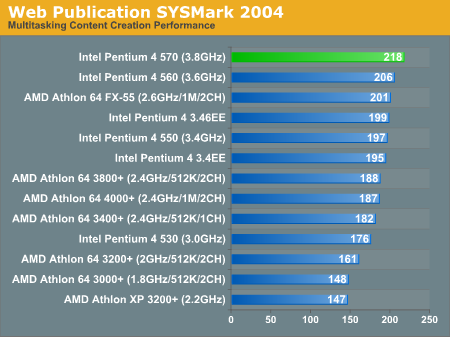
Mozilla + Media Encoder
While AMD dominated in WorldBench 5's Mozilla test, encoding a file using Windows Media Encoder in the background not only makes this test more appreciative of the Pentium 4 but also of Hyper Threading.
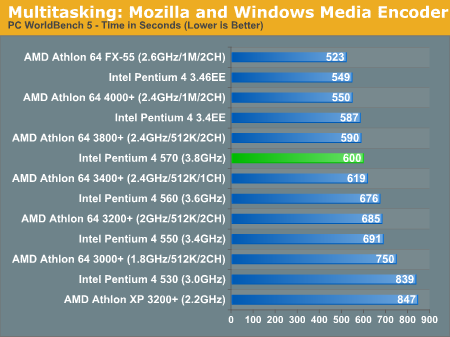
Video Creation/Photo Editing
Adobe Photoshop 7.0.1
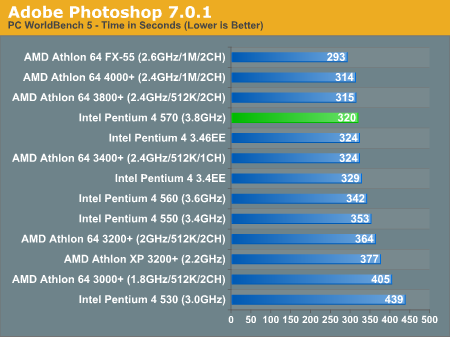
Adobe Premier 6.5
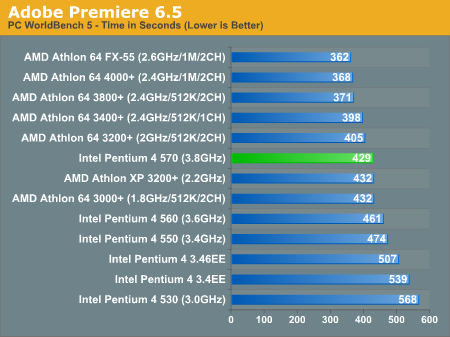
Roxio VideoWave Movie Creator 1.5
While Premier is a wonderful professional application, consumers will prefer something a little easier to use. Enter: Roxio's VideoWave Movie Creator, a fairly full featured yet consumer level video editing package.
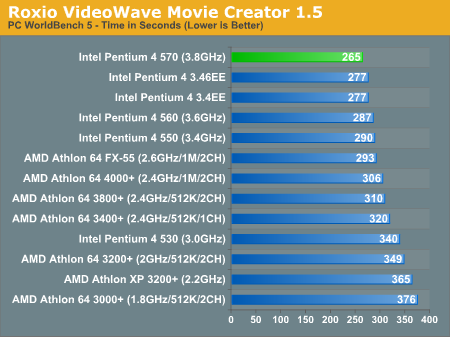
Audio/Video Encoding
MusicMatch Jukebox 7.10
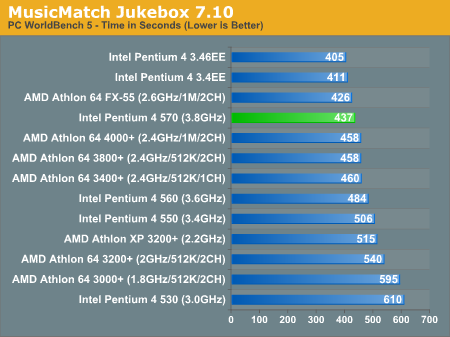
DivX 5.2.1 with AutoGK
Armed with the latest version of DivX (5.2.1) and the AutoGK front end for Gordian Knot, we took all of the processors to task at encoding a chapter out of Pirates of the Caribbean. We set AutoGK to give us 75% quality of the original DVD rip and did not encode audio.
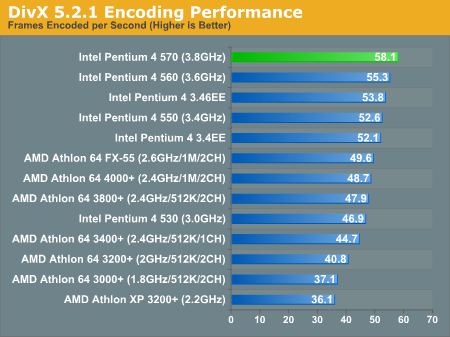
XviD 5 with AutoGK
Another very popular codec is the XviD codec, and thus we measured encoding performance using it instead of DivX for this next test. The rest of the variables remained the same as the DivX test.
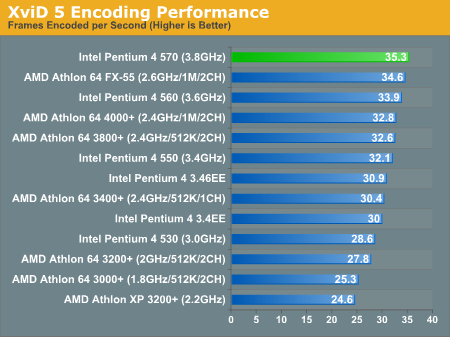
Windows Media Encoder 9
To finish up our look at Video Encoding performance we've got two tests both involving Windows Media Encoder 9. The first test is WorldBench 5's WMV9 encoding test.
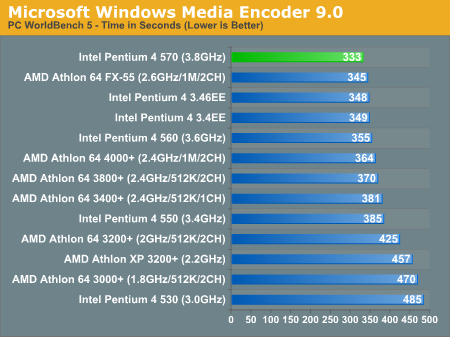
Next we have our own home-brewed HD encoding test:
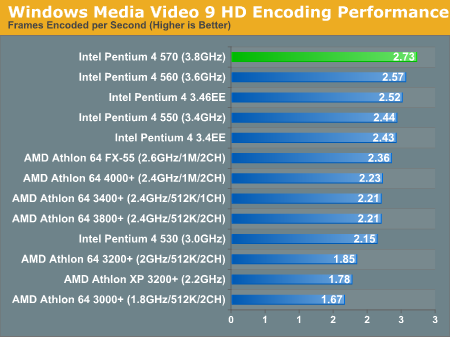
Gaming Performance
Doom 3
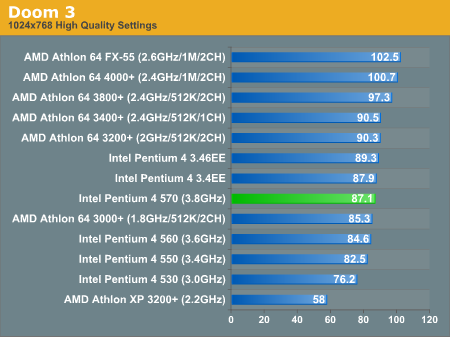
Counterstrike: Source
Half Life 2 is coming this week, here's a preview of what CPUs will run the game the best:
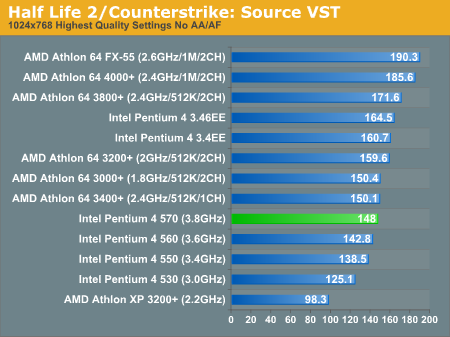
Halo
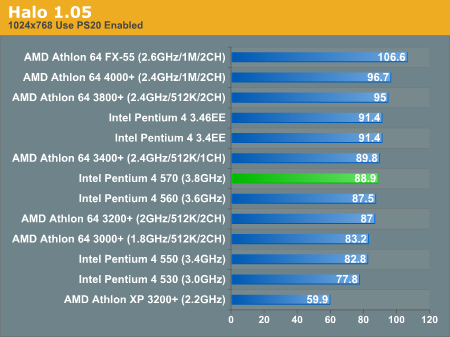
Star Wars Battlefront
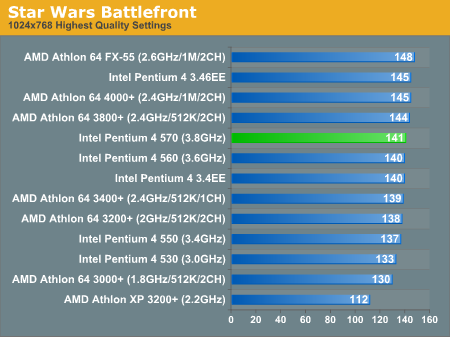
Battlefield Vietnam
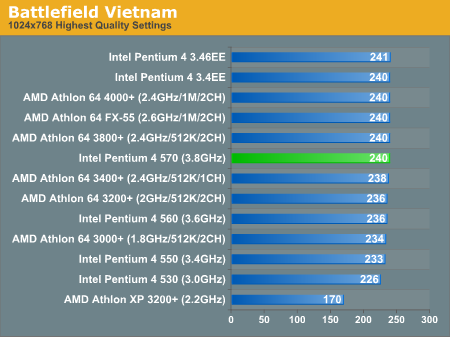
Unreal Tournament 2004
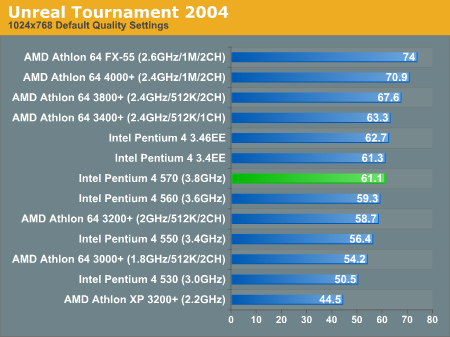
Wolfenstein: Enemy Territory
An oldie but a goodie, Enemy Territory is still played quite a bit and makes for a great CPU test as today's GPUs can easily handle the rendering load of the Quake 3 based game.
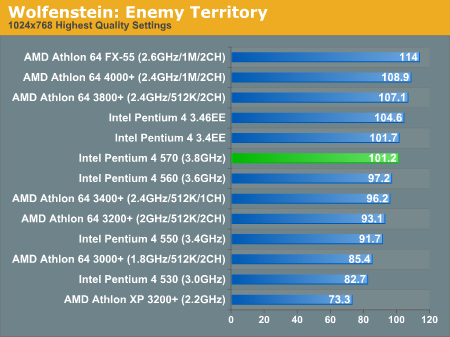
The Sims 2
While a clear departure from our usual game tests, The Sims 2 is more popular than any of the other games we've featured here in certain crowds - it is effectively the Doom 3 of those who prefer life-simulation to first person shooters. And interestingly enough, it makes for a very impressive CPU benchmark.
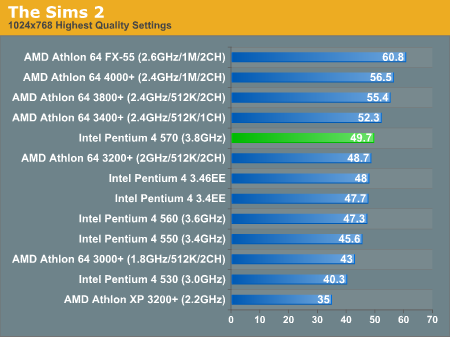
Far Cry

Warcraft III

3D Rendering
3dsmax 5.1
WorldBench includes two 3dsmax benchmarks using version 5.1 of the popular 3D rendering and animation package: a DirectX and an OpenGL benchmark.
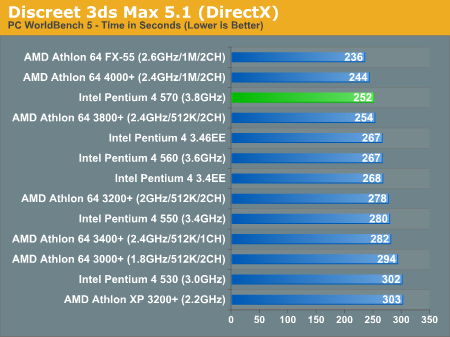

3dsmax 6
For the next 3dsmax test we used version 6 of the program and ran the SPECapc rendering tests to truly stress these CPUs. Since there's not much new to report here we're only going to report the Rendering Composite score.
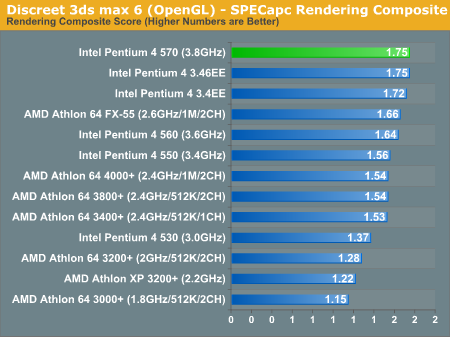
Workstation Applications
Visual Studio 6
Carried over from our previous CPU reviews, we continue to use Visual Studio 6 for a quick compile test. We are still using the Quake 3 source code as our test and measure compile time in seconds.

SPECviewperf 8
For our next set of professional application benchmarks we turn to SPECviewperf 8. SPECviewperf is a collection of application traces taken from some of the most popular professional applications, and compiled together in a single set of benchmarks used to estimate performance in the various applications the benchmark is used to model. With version 8, SPEC has significantly improved the quality of the benchmark, making it even more of a real world indicator of performance.
We have included SPEC's official description of each one of the 8 tests in the suite.
3dsmax Viewset (3dsmax-03)
"The 3dsmax-03 viewset was created from traces of the graphics workload generated by 3ds max 3.1. To insure a common comparison point, the OpenGL plug-in driver from Discreet was used during tracing.
The models for this viewset came from the SPECapc 3ds max 3.1 benchmark. Each model was measured with two different lighting models to reflect a range of potential 3ds max users. The high-complexity model uses five to seven positional lights as defined by the SPECapc benchmark and reflects how a high-end user would work with 3ds max. The medium-complexity lighting models uses two positional lights, a more common lighting environment.
The viewset is based on a trace of the running application and includes all the state changes found during normal 3ds max operation. Immediate-mode OpenGL calls are used to transfer data to the graphics subsystem."
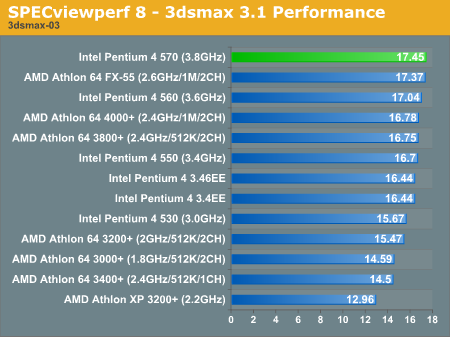
CATIA Viewset (catia-01)
"The catia-01 viewset was created from traces of the graphics workload generated by the CATIATM V5R12 application from Dassault Systems.
Three models are measured using various modes in CATIA. Phil Harris of LionHeart Solutions, developer of CATBench2003, supplied SPEC/GPC with the models used to measure the CATIA application. The models are courtesy of CATBench2003 and CATIA Community.The car model contains more than two million points. SPECviewperf replicates the geometry represented by the smaller engine block and submarine models to increase complexity and decrease frame rates. After replication, these models contain 1.2 million vertices (engine block) and 1.8 million vertices (submarine).
State changes as made by the application are included throughout the rendering of the model, including matrix, material, light and line-stipple changes. All state changes are derived from a trace of the running application. The state changes put considerably more stress on graphics subsystems than the simple geometry dumps found in older SPECviewperf viewsets.
Mirroring the application, draw arrays are used for some tests and immediate mode used for others."
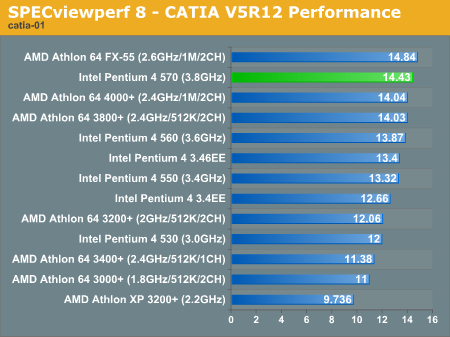
Lightscape Viewset (light-07)
"The light-07 viewset was created from traces of the graphics workload generated by the Lightscape Visualization System from Discreet Logic. Lightscape combines proprietary radiosity algorithms with a physically based lighting interface.
The most significant feature of Lightscape is its ability to accurately simulate global illumination effects by precalculating the diffuse energy distribution in an environment and storing the lighting distribution as part of the 3D model. The resulting lighting "mesh" can then be rapidly displayed."
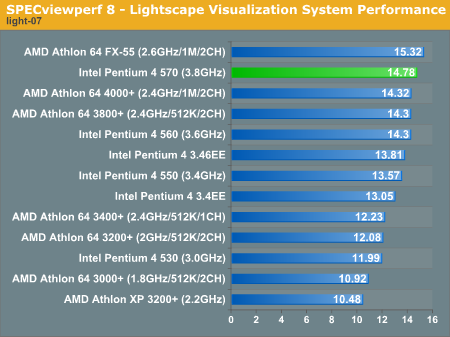
Maya Viewset (maya-01)
"The maya-01 viewset was created from traces of the graphics workload generated by the Maya V5 application from Alias.
The models used in the tests were contributed by artists at NVIDIA. Various modes in the Maya application are measured.
State changes as made by the application are included throughout the rendering of the model, including matrix, material, light and line-stipple changes. All state changes are derived from a trace of the running application. The state changes put considerably more stress on graphics subsystems than the simple geometry dumps found in older viewsets.
As in the Maya V5 application, array element is used to transfer data through the OpenGL API."

Pro/ENGINEER (proe-03)
"The proe-03 viewset was created from traces of the graphics workload generated by the Pro/ENGINEER 2001TM application from PTC.
Two models and three rendering modes are measured during the test. PTC contributed the models to SPEC for use in measurement of the Pro/ENGINEER application. The first of the models, the PTC World Car, represents a large-model workload composed of 3.9 to 5.9 million vertices. This model is measured in shaded, hidden-line removal, and wireframe modes. The wireframe workloads are measured both in normal and antialiased mode. The second model is a copier. It is a medium-sized model made up of 485,000 to 1.6 million vertices. Shaded and hidden-line-removal modes were measured for this model.
This viewset includes state changes as made by the application throughout the rendering of the model, including matrix, material, light and line-stipple changes. The PTC World Car shaded frames include more than 100MB of state and vertex information per frame. All state changes are derived from a trace of the running application. The state changes put considerably more stress on graphics subsystems than the simple geometry dumps found in older viewsets.
Mirroring the application, draw arrays are used for the shaded tests and immediate mode is used for the wireframe. The gradient background used by the Pro/E application is also included to better model the application workload."

SolidWorks Viewset (sw-01)
"The sw-01 viewset was created from traces of the graphics workload generated by the Solidworks 2004 application from Dassault Systemes.
The model and workloads used were contributed by Solidworks as part of the SPECapc for SolidWorks 2004 benchmark.
State changes as made by the application are included throughout the rendering of the model, including matrix, material, light and line-stipple changes. All state changes are derived from a trace of the running application. The state changes put considerably more stress on graphics subsystems than the simple geometry dumps found in older viewsets.
Mirroring the application, draw arrays are used for some tests and immediate mode used for others."
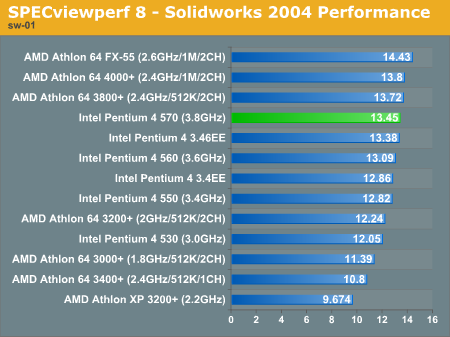
Unigraphics (ugs-04)
"The ugs-04 viewset was created from traces of the graphics workload generated by Unigraphics V17.
The engine model used was taken from the SPECapc for Unigraphics V17 application benchmark. Three rendering modes are measured -- shaded, shaded with transparency, and wireframe. The wireframe workloads are measured both in normal and anti-alised mode. All tests are repeated twice, rotating once in the center of the screen and then moving about the frame to measure clipping performance.
The viewset is based on a trace of the running application and includes all the state changes found during normal Unigraphics operation. As with the application, OpenGL display lists are used to transfer data to the graphics subsystem. Thousands of display lists of varying sizes go into generating each frame of the model.
To increase model size and complexity, SPECviewperf 8.0 replicates the model two times more than the previous ugs-03 test."
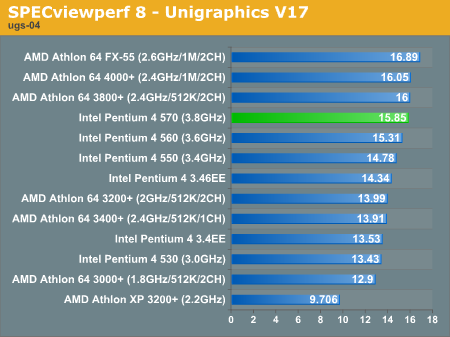
Power Consumption
To measure power consumption we looked at overall system power consumption and tried to keep as many variables static. There are some basic differences which we cannot get around, mainly that the 925X uses lower voltage DDR-II while the nForce4 uses regular DDR, but for the most part our results were quite controlled. We also included power consumption figures from 130nm Socket-939 Athlon 64 3200+ and 3000+ chips, which as you may know, do not exist. The reason we did this was to show the sharp contrast to the power consumption figures of the 90nm 3500+ we've included in the charts below.
We measured power consumption in two states: idle sitting at the Windows desktop and under load while running our Windows Media Encoder 9 test, which proved to be one of the most strenuous CPU tests we ran as it pretty much isolated the CPU subsystem.
The Pentium 4 570J tops the charts as the heaviest power consumer out of our collection of CPUs here, which is no surprise. Since the 570J here is a different chip than the other Pentium 4s, its not too unsual to see slightly lower idle power consumption given that different chips in the Pentium 4 family can have different operating voltages.
We can't wait until AMD brings more of their Athlon 64 chips down to 90nm next year so that we may have an even cooler running Athlon 64 4000+.
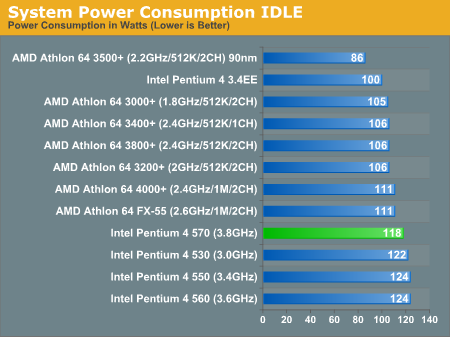
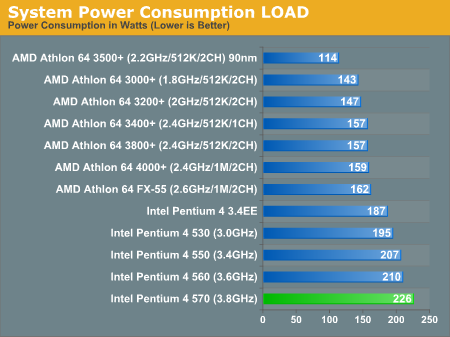
Final Words
With the 570J being the last desktop Pentium 4 launched in 2004 (once again, not counting the Extreme Edition), it looks like AMD will close out this year on top, which is fitting considering how strong AMD has been throughout the entire year.
Looking at the performance of the Pentium 4 570J it's clear that had Intel launched the 4GHz Pentium 4 things would have been much more competitive than we first thought. AMD would still hold the crown in gaming performance, but Intel would have been able to pick up a lot of lost steam in other areas and continue to solidify leads in content creation, 3D rendering and encoding applications.
We're still being cautiously pessimistic about the types of performance gains we'll see from the upcoming 600 series of CPUs from Intel. As you may have already read, Intel is planning on doubling the L2 cache of Prescott and launching a new 600 series of CPUs next year. With twice the L2 cache Intel will attempt to get most of the benefits of an on-die memory controller, mainly reduced memory access latencies, without actually implementing one. We've seen the positive impact this can have with Intel's Extreme Edition chips, but even then, it may not be enough. Raw clock speed is what the Pentium 4's architecture was designed for, and only that will give Intel a commanding lead - unfortunately for them 3.8GHz does seem to be the end of the road for quite a while.
The performance paradigm will eventually shift to being more depending on multithreading capabilities, but that transition is far from being complete, especially on the desktop. It may end up being that Longhorn in 2006 is when we start to reap the benefits of more than just clock speed with every processor release.
Right now we couldn't be happier with AMD, they are more on top of their game today than they ever were with the Athlon XP and the Athlon 64 platform is by far the most attractive platform AMD has ever had. We've seen AMD offer leading performance in the past, but never have they commanded such a strong lead for such an incredible length of time. If AMD could have repeat of 2004 next year the few companies that still don't take them seriously enough may finally come around.

